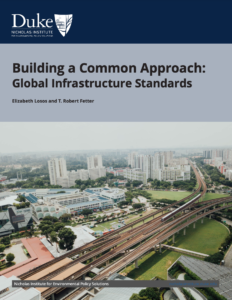Full Title: Building a Common Approach: Global Infrastructure Standards
Author(s): Elizabeth Losos and T. Robert Fetter
Publisher(s): Nicholas Institute for Environmental Policy Solutions
Publication Date: June 30, 2022
Full Text: Download Resource
Description (excerpt):
Well-planned, -designed, and -built infrastructure projects are critically needed to improve economic productivity, transition to a low-carbon economy, mitigate environmental risks, and promote human rights and social inclusion. The urgency is greatest in emerging and developing economies. Encouragingly, both public—and private—sector investors are increasingly designating funds for just these types of infrastructure projects. A recent surge in public development finance (e.g., the United States’ Build Back Better World, European Union’s Global Gateway, and United Kingdom’s Clean Green Initiative), in conjunction with existing bilateral and multilateral infrastructure initiatives (e.g., China’s Belt and Road Initiative, the Asian Infrastructure Investment Bank), represent potentially hundreds of billions of dollars in new loans for green, sustainable, and quality infrastructure investments and guarantees. In the private sector, institutional investors such as pension funds are increasingly seeking sustainable, low-risk investments for their rapidly expanding environmental, social and governance (ESG) funds— potentially representing billions more for sustainable, quality infrastructure projects.
And yet sustainable, quality infrastructure is still not being constructed at nearly the rate needed, especially in Middle- and Low-Income Countries (MLICs). A persistent barrier to tapping into financial resources is the absence of a reliable and widely recognized global standard or signal that identifies “bankable” infrastructure projects with low environmental, social, and governance risks, high debt transparency, and reliable economic returns over a project’s life cycle. While there are a multitude of existing standards, rating systems, and guidelines for various aspects of infrastructure sustainability and quality, users find them difficult to distinguish. Consequently, the current landscape provides more confusion than clarity when selecting which infrastructure investments will support local, national, and global needs.
